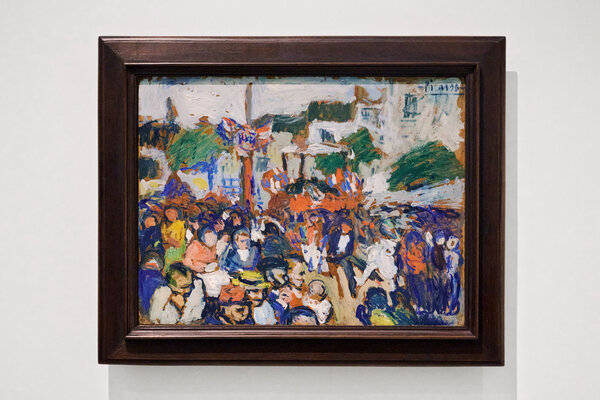
Picasso’s “Le Moulin de la Galette,” circa November 1900, on display at the Guggenheim Museum.Credit…Estate of Pablo Picasso/Artists Rights Society (ARS), New York; Vincent Tullo for The New York Times
What follows is a brief excerpt from a superb article by , featured in The New York Times (May 11, 2023).
* * *
A small, exquisite exhibition at the Guggenheim shows how the City of Light transformed the 19-year-old Spanish artist. One painting says it all.
Organized by Megan Fontanella, the Guggenheim’s curator of modern art and provenance, this show is one of over 30 mounted in European and American museums as part of “Picasso Celebration: 1973-2023,” which has been spearheaded by the Musée Picasso-Paris on the occasion of the 50th anniversary of the artist’s death. The point seems to be that in the half-century since then, the legacy of the 20th century’s greatest artist remains undiminished, continues to influence new generations of artists and still contains mysteries to be discovered by scholars and new technologies.
The Guggenheim show hits all of these marks. The museum has used the celebration as an impetus to continue the analysis (initiated in 2018) and undertake the conservation of its best-known and most beloved Picasso painting: “Le Moulin de la Galette,” of 1900, and to make this beguiling, subtly refreshed work the centerpiece of “Young Picasso.”
As Picasso shows go, it has a distinctive lightness. For one thing it contains only 10 works. But it is also unburdened by the artist’s oppressively unforgettable, often disturbing life story, of which there was as yet not much. It gives us Picasso before he was Picasso, which was in essence Picasso before he knew Paris.
He had traveled there from Barcelona by train with his friend, the Spanish poet and painter Carles Casagemas, in order to visit the Universal Exhibition, which was nearing its conclusion. He wanted to see a painting of his hanging in the Spanish Pavilion. This was “Last Moments” from 1898, which he repainted in 1903 as “La Vie,” a high point of his Blue Period.
But Picasso’s larger mission was to breathe in Paris — the capital of the 19th century in Walter Benjamin’s words — and take a crash course in modern French painting. During the visit he worked hard in studios shared with other artists and often their models. And he voraciously sampled everything the city had to offer a frighteningly talented, ambitious, curious, sociable yet provincial young artist. He visited museums to see older art and galleries for the latest thing. He partook of the glamorous bohemian nightlife in cafes, cabarets and dance halls, of which “Le Moulin de la Galette” was the most famous.


And he got to know people, initially Spanish artists and writers, some of whom he had known in Barcelona, and a widening circle of Parisians as he learned French.
At the Guggenheim, “Le Moulin de la Galette” occupies pride of place in a large gallery painted in a slightly cool (in temperature) dark blue. Reigning in magnificent solitude from one of the longest walls, this seductive wide-angle view depicts a dance hall full of beautiful people — elegantly turned-out women and top-hatted men — who dance, drink and exchange pleasantries or gossip while their eyes slide away, perhaps seeking out the very topic of discussion. It is relatively quiet — Picasso would also paint cancan dancers, but not now — a suave, sophisticated crowd painted by an artist who understood its fashions, body language and interpersonal connections perfectly.
* * *
Here is a direct link to the complete article.